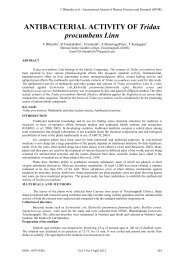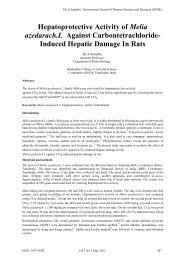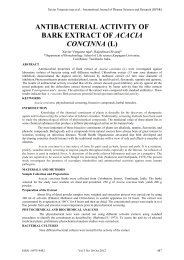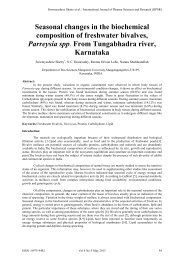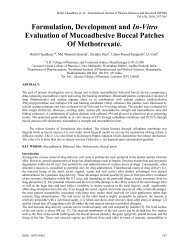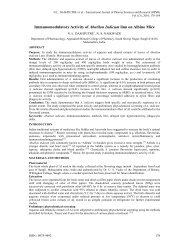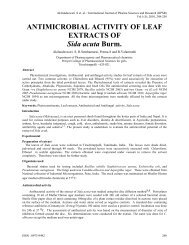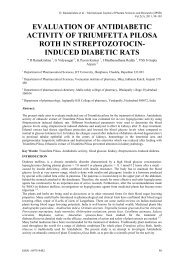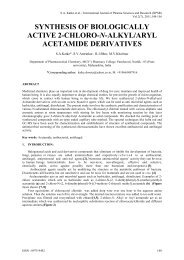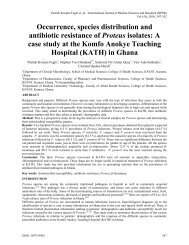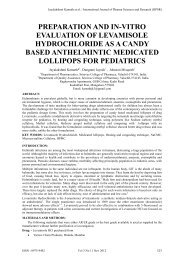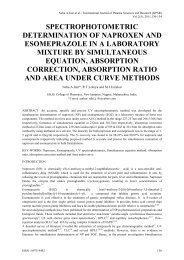Quantitative analysis of piperine in ayurvedic - international journal ...
Quantitative analysis of piperine in ayurvedic - international journal ...
Quantitative analysis of piperine in ayurvedic - international journal ...
Create successful ePaper yourself
Turn your PDF publications into a flip-book with our unique Google optimized e-Paper software.
Gupta Vishvnath et al. / International Journal <strong>of</strong> Pharma Sciences and Research (IJPSR)<br />
Vol.2(2), 2011, 58-61<br />
<strong>Quantitative</strong> <strong>analysis</strong> <strong>of</strong> <strong>piper<strong>in</strong>e</strong> <strong>in</strong><br />
<strong>ayurvedic</strong> formulation by UV<br />
Spectrophotometry<br />
Gupta Vishvnath and Ja<strong>in</strong> U. K.*<br />
Bhopal Institute <strong>of</strong> Technology & Science-Pharmacy, Bhopal (M.P)<br />
Abstract<br />
A simple and reproducible UV- spectrophotometric method for the quantitative determ<strong>in</strong>ation <strong>of</strong> <strong>piper<strong>in</strong>e</strong> <strong>in</strong><br />
Sitopaladi churna (STPLC) were developed and validated <strong>in</strong> the present work. The parameters l<strong>in</strong>earity,<br />
precision , accuracy, and standard error were studies accord<strong>in</strong>g to <strong>in</strong>dian herbal pharmacopiea.<br />
In this present study a new, simple, rapid, sensitive, precise and economic spectrophotometric method <strong>in</strong><br />
ultraviolet region has been developed for the determ<strong>in</strong>ation <strong>of</strong> <strong>piper<strong>in</strong>e</strong> <strong>in</strong> market and laboratory herbal<br />
formulation <strong>of</strong> Sitopaladi churna. which were procured and purchased respectively from the local market and<br />
they were evaluated as per Indian herbal Pharmacopoeia and WHO guidel<strong>in</strong>es. The concentration <strong>of</strong> <strong>piper<strong>in</strong>e</strong><br />
present <strong>in</strong> raw material <strong>of</strong> PSC was found to be 1.45±0.014 w/w <strong>in</strong> piper longum fruits. Piper<strong>in</strong>e has the<br />
maximum wavelength at 342.5 nm and hence the UV spectrophotometric method was performed at 342.5 nm.<br />
The samples were prepared <strong>in</strong> methanol and methos obeys Beers law <strong>in</strong> concentration ranges employed for<br />
evaluation. The content <strong>of</strong> <strong>piper<strong>in</strong>e</strong> <strong>in</strong> <strong>ayurvedic</strong> formulation was determ<strong>in</strong>ed. The result <strong>of</strong> <strong>analysis</strong> have been<br />
validated statistically and recovery studies confirmed the accuracy <strong>of</strong> the proposed method. Hence the proposed<br />
method can be used for the reliable quantification <strong>of</strong> Piper<strong>in</strong>e <strong>in</strong> crude drug and its herbal formulation.<br />
Key words: f<strong>in</strong>ger pr<strong>in</strong>t<strong>in</strong>g, <strong>piper<strong>in</strong>e</strong>, Sitopaladichurna, UV-Spectrophotometer.<br />
Introduction<br />
The formulation <strong>of</strong> Sitopaladi churna (STPLC) is well known <strong>ayurvedic</strong> formulation is <strong>of</strong>ficial <strong>in</strong> Ayurvedic<br />
Formulary <strong>of</strong> India, traditionally used for asthma, cough and cold, Tuberculosis, chest pa<strong>in</strong>, epistaxis, chronic<br />
rh<strong>in</strong>itis / s<strong>in</strong>usitis, coryza and other respiratory disorders 3 .Through it is very popular medic<strong>in</strong>e, no establishment<br />
<strong>of</strong> quality control for this drug studies have been performed yet. This paper reports on <strong>in</strong>strumental methods for<br />
ensur<strong>in</strong>g the Identity, Potency, Purity, Safety and efficacy <strong>of</strong> the Sitopaladi churna. This paper <strong>in</strong>cludes<br />
estimation <strong>of</strong> <strong>piper<strong>in</strong>e</strong> for different samples <strong>of</strong> Sitopaladi churna (STPLC) and comparison studies between<br />
marketed formulations as STPLC-A, STPLC-B and STPLC-C and lab formulations as STPLC-I, STPLC-II,<br />
STPLC-III by UV spectroscopic methods.<br />
Spectroscopic studies were carried out to develop the spectrum <strong>of</strong> the formulation and validated<br />
by overla<strong>in</strong> and l<strong>in</strong>earity study (Beer's law).The results <strong>of</strong> all batches were found <strong>in</strong> close proximity with each<br />
other. The methods used for determ<strong>in</strong>ation <strong>of</strong> Sitopaladi churna found to be precise, reproducible and can be<br />
considered for rout<strong>in</strong>e quality control and f<strong>in</strong>ger pr<strong>in</strong>t<strong>in</strong>g <strong>of</strong> the formulation.The present study is an attempt to<br />
develop the f<strong>in</strong>gerpr<strong>in</strong>t<strong>in</strong>g method for Sitopaladi churna (STPLC) by spectrophotometric determ<strong>in</strong>ation us<strong>in</strong>g<br />
Piper<strong>in</strong>e as a standard, which is an importanat and major content <strong>in</strong> formulation. The developed spectroscopic<br />
f<strong>in</strong>gerpr<strong>in</strong>ts can be used as a standard and <strong>piper<strong>in</strong>e</strong> can be used as a possible marker compound for<br />
f<strong>in</strong>gerpr<strong>in</strong>t<strong>in</strong>g <strong>of</strong> STPLC.<br />
1.Material and Methods:<br />
Procurement <strong>of</strong> crude drug<br />
Sitopaladi churna (STPLC) consist <strong>of</strong> 5 <strong>in</strong>gredients viz., Sitopala ,Bambusa bambos, Piper longum,<br />
C<strong>in</strong>namommum zeylanicum, Elettaria cardamomum.<br />
All these 5 <strong>in</strong>gredients were procured from local market and identified morphologically 1 , microscopically and<br />
compared with standard Pharmacopoeial monograph 4,5,6,7 . Samples <strong>of</strong> crude drugs were also authenticated by<br />
Department <strong>of</strong> Botany, Dr. H.S.Gour Vishwavidyalaya ,Sagar (M.P.)<br />
ISSN : 0975-9492 58
Gupta Vishvnath et al. / International Journal <strong>of</strong> Pharma Sciences and Research (IJPSR)<br />
Vol.2(2), 2011, 58-61<br />
Preparation <strong>of</strong> the formulation STPLC<br />
Three marketed formulation <strong>of</strong> Sitopaladi churna from different manufactures (designated as STPLC-A,<br />
STPLC-B and STPLC-C) and three laboratory batches <strong>of</strong> Sitopaladi churna were prepared <strong>in</strong> local laboratory<br />
and were named as STPLC-I ,STPLC-II, STPLC-III. were procured for the present study 2 .<br />
2. Chemicals<br />
All the chemicals and solvents were used <strong>of</strong> A.R. grade, standard <strong>piper<strong>in</strong>e</strong>(98%) was procured from<br />
Lancaster(England).<br />
Preparation <strong>of</strong> <strong>piper<strong>in</strong>e</strong> extract <strong>of</strong> Sitopaladi churna<br />
Reflux the powderd Sitopaladi churna(1gm) with 60 ml ethanol for 1 hour. Filter the extract and reflux the marc<br />
left with 40 ml <strong>of</strong> methanol for another 1 hour.filter and comb<strong>in</strong>e the filtrate. Concentrate the methanol extract<br />
under vaccum till the semisolid mass is obta<strong>in</strong>ed.dissolve the residue <strong>in</strong> 75 ml methanol and filter through<br />
s<strong>in</strong>tered glass funnel (G-2) by vaccum filtration assembly. The filtrate was centrifuged at 2000 rpm for 20<br />
m<strong>in</strong>utes, the supernatant was collected <strong>in</strong> 100ml volumetric flask and volume was made with methanol. The<br />
same procedure was performed for each batch <strong>of</strong> Sitopaladi churna and separately powderd fruits <strong>of</strong> piper<br />
longum (Pippli) and solution (100ml)<strong>of</strong> their <strong>piper<strong>in</strong>e</strong> extract were prepared 8 .<br />
Preparation <strong>of</strong> standard solution <strong>of</strong> <strong>piper<strong>in</strong>e</strong><br />
An accurately weighed <strong>piper<strong>in</strong>e</strong>(100mg)was dissolved <strong>in</strong> methanol and volume was made up to 100ml with<br />
methanol <strong>in</strong> volumetric flask. Two ml <strong>of</strong> this solution was diluted with methanol up to 100ml <strong>in</strong> volumetric<br />
flask to give 20µg/ml <strong>piper<strong>in</strong>e</strong> solution.<br />
Experimental<br />
Calibration curve from standard solution <strong>of</strong> <strong>piper<strong>in</strong>e</strong> was prepared and with the help <strong>of</strong> this curve the content <strong>of</strong><br />
<strong>piper<strong>in</strong>e</strong> from Sitopaladi churna was estimated. The method was validated for precision and accuracy.<br />
Calibration curve <strong>of</strong> <strong>piper<strong>in</strong>e</strong> <strong>in</strong> STPLC<br />
A series <strong>of</strong> calibrated 10ml volumetric flask were taken and appropriate aliquots <strong>of</strong> the work<strong>in</strong>g standard<br />
solution <strong>of</strong> <strong>piper<strong>in</strong>e</strong> were withdrawn and diluted up to 10ml with methanol.the absorbance was measured at<br />
absorption maxima 342.5 nm, aga<strong>in</strong>st the reagent blank prepared <strong>in</strong> similar manner without the <strong>piper<strong>in</strong>e</strong>. The<br />
absorption maxima and Beer’s law limit were recorded and data that prove the l<strong>in</strong>erity and obey Bee’r law limit<br />
were noted.<br />
The l<strong>in</strong>ear correlation between these concentrations(x-axis) and absorbance(y-axis) were<br />
graphically presented and slope(b), <strong>in</strong>tercept(a), and correlation confficiant (r 2 ) were calculated for the l<strong>in</strong>ear<br />
equation (Y=bx+a) by regression us<strong>in</strong>g the methanol <strong>of</strong> the least square, Table1 figure1.<br />
Validation parameters <strong>of</strong> <strong>piper<strong>in</strong>e</strong> <strong>in</strong> STPLC (Mean% ± SD,n=3): Table-1<br />
Sno. parameters value<br />
01 Absorption maxima 342.5nm<br />
02 Beer’s law limit 10-50ug/ml<br />
03 Regression equation(y=bx+a) 0.013x+0<br />
04 Intercept(a) 0<br />
05 Slope(b) 0.013<br />
06 Correlation coefficients(r2) 0.9961<br />
07 Precision (n=6, % RSD) 0.978<br />
08 Accuracy(%) 99.03<br />
ISSN : 0975-9492 59
Gupta Vishvnath et al. / International Journal <strong>of</strong> Pharma Sciences and Research (IJPSR)<br />
Vol.2(2), 2011, 58-61<br />
Calibration curve <strong>of</strong> <strong>piper<strong>in</strong>e</strong>: (figure1).<br />
s.no. Concentration (µgm/ml) absorbance<br />
01 10 0.15<br />
02 20 0.269<br />
03 30 0.395<br />
04 40 0.518<br />
05 50 0.641<br />
Figure-1: Calibration curve <strong>of</strong> <strong>piper<strong>in</strong>e</strong> <strong>in</strong> STPLC<br />
Estimation <strong>of</strong> <strong>piper<strong>in</strong>e</strong> <strong>in</strong> STPLC<br />
The appropriate aliquots from <strong>piper<strong>in</strong>e</strong> extract <strong>of</strong> each batch <strong>of</strong> Sitopaladi churna and separately powderd fruits<br />
<strong>of</strong> piper longum (Pippli) were withdrawn <strong>in</strong> 10ml volumetric flask separately absorbance for aliquots <strong>of</strong> each<br />
was noted at 342.5 nm. the correspond<strong>in</strong>g concentration <strong>of</strong> <strong>piper<strong>in</strong>e</strong> aga<strong>in</strong>st respective absorbance value was<br />
determ<strong>in</strong>es us<strong>in</strong>g the <strong>piper<strong>in</strong>e</strong> calibration curve. The statistical <strong>analysis</strong> for check<strong>in</strong>g uniformity <strong>in</strong> batches is<br />
also performed below(Table-2).<br />
s.no. name Piper<strong>in</strong>e content %w/w<br />
01 piper longum(pippli) 1.45±0.34<br />
02 STPLC-I 0.31±0.008<br />
03 STPLC-II 0.34±0.002<br />
04 SITOPALADI STPLC-III 0.32±0.003<br />
CHURNA<br />
05 STPLC-A 0.70±0.002<br />
06 STPLC-B 0.72±0.005<br />
07 STPLC-C 0.75±0.006<br />
Precision and accuracy<br />
The methanol was validated for precision and accuracy by perform<strong>in</strong>g the recovery studies at two levels by<br />
add<strong>in</strong>g known amount <strong>of</strong> <strong>piper<strong>in</strong>e</strong> extract <strong>of</strong> Sitopaladi churna, <strong>of</strong> which the <strong>piper<strong>in</strong>e</strong> content have been<br />
estimated previously. The data were obta<strong>in</strong>ed and recovery was calcuted.(Table-3).<br />
ISSN : 0975-9492 60
Gupta Vishvnath et al. / International Journal <strong>of</strong> Pharma Sciences and Research (IJPSR)<br />
Vol.2(2), 2011, 58-61<br />
Data <strong>of</strong> recovery study (Mean% ± SD,n=3): .(Table-3).<br />
S.no. Amount <strong>of</strong> <strong>piper<strong>in</strong>e</strong>(µgm/ml) RSD% SE Recovery%<br />
In sample added estimated<br />
01 100 50 149.62±0.86 0.57 0.32 99.74<br />
02 100 100 199.26±0.42 0.21 0.12 99.63<br />
03 100 150 249.30±0.12 0.04 0.023 99.72<br />
mean 0.27 0.15 99.69<br />
Mean ± SD <strong>of</strong> six determ<strong>in</strong>ations, RSD= Relative standard deviation ,<br />
SE=Standard error<br />
Results and Discussion<br />
Piper<strong>in</strong>e obeys Beer Lambert’law <strong>in</strong> concentration range 10-50µg/ml at the λ max 342.5 nm. The correlation<br />
coefficiant (r 2 ) was calculated where the (r 2 ) value 0.9961 <strong>in</strong>dicates the good l<strong>in</strong>earity between the<br />
concentration and absorbance.<br />
The estimation <strong>of</strong> <strong>piper<strong>in</strong>e</strong> <strong>in</strong> Sitopaladi churna (laboratory batch STPLC-I, STPLC-II and STPLC-III and<br />
marketed formulations STPLC-A, STPLC-B, and STPLC-C ) and powderd fruits <strong>of</strong> piper longum was carried<br />
out separately. The concentration <strong>of</strong> <strong>piper<strong>in</strong>e</strong> present <strong>in</strong> raw material was found to be 1.45±0.341 w/w <strong>in</strong> piper<br />
longum fruit. The concentration <strong>of</strong> <strong>piper<strong>in</strong>e</strong> <strong>in</strong> different batches <strong>of</strong> STPLC(laboratory batches STPLC-I, STPLC-<br />
II and STPLC-III)was found to be 0.31±0.008%, 0.34±0.002 %,0.32±0.003 % and <strong>in</strong> marketed formulations<br />
STPLC-A, STPLC-B, and STPLC-C was found to be 0.70±0.002 %, 0.72±0.005 %, 0.75±0.006 %<br />
respectively(In Table-2).<br />
In order to opta<strong>in</strong> precision and accuracy the recovery study were performed at three levels by<br />
add<strong>in</strong>g known amount <strong>of</strong> <strong>piper<strong>in</strong>e</strong> with preanalysed sample <strong>of</strong> <strong>piper<strong>in</strong>e</strong> <strong>in</strong> Sitopaladi churna (STPLC). The<br />
experment was repeated Six Times at both level(Table-3) and result shows 99.74%, 99.63%,and 99.72%<br />
recovery <strong>of</strong> <strong>piper<strong>in</strong>e</strong> at all the level with mean value 99.69%, which prove reproductibility <strong>of</strong> the result. This<br />
shows significant precision <strong>of</strong> methods at 95% confidence level. The % relative standard deviation(%RSD)<br />
value was found to be 0.57, 0.21,and 0.04, with mean 0.27 at all the level while the standard error was 0.32, 0.12<br />
and 0.023 with Mean 0.15 respectively. From the data it is obvious that the present method <strong>of</strong> UV-<br />
Spectrophotometric f<strong>in</strong>gerpr<strong>in</strong>t<strong>in</strong>g determ<strong>in</strong>ation <strong>of</strong> Piper<strong>in</strong>e is simple, precise, accurate, and suitable for rout<strong>in</strong>e<br />
<strong>analysis</strong> <strong>of</strong> Piper<strong>in</strong>e <strong>in</strong> Sitopaladi churna (STPLC).<br />
Conclusion<br />
Development and validation <strong>of</strong> spectrophotometric method for the estimation <strong>of</strong> <strong>piper<strong>in</strong>e</strong> <strong>in</strong> Sitopaladi churna<br />
could be used as a valuable analytical tool <strong>in</strong> rout<strong>in</strong>e <strong>analysis</strong>, to check the batch to batch variations After the<br />
drug is approved , pharmaceutical validation and development <strong>of</strong> f<strong>in</strong>ger pr<strong>in</strong>t<strong>in</strong>g and are necessary to ensure<br />
that the drug product will meet/set pharmaceutical standards for identity, strength, quality,purity, stability,<br />
evaluation safety and efficacy. In general, pharmaceutical development <strong>of</strong> f<strong>in</strong>ger pr<strong>in</strong>t<strong>in</strong>g provide a certa<strong>in</strong><br />
assurance <strong>of</strong> batch uniformity and <strong>in</strong>tegrity <strong>of</strong> the product manufactured. Estimation <strong>of</strong> <strong>piper<strong>in</strong>e</strong> can be used as<br />
one <strong>of</strong> the appropriate analytical markers for the f<strong>in</strong>ger pr<strong>in</strong>t<strong>in</strong>g.<br />
Acknowledgement<br />
The authors are grateful to Pr<strong>in</strong>cipal, BITS-Pharmacy college , Bhopal for their unforgetable support.<br />
References<br />
[1] Kokate CK, Purohit AP, Khandelwal KR. Pharmacognosy, 29th edition, New Delhi: Nirali Prakashan 2002;550-9.<br />
[2] The Ayurvedic Formulary <strong>of</strong> India, Part-I, II nd edition, New Delhi: Govt. <strong>of</strong> India, M<strong>in</strong>istry <strong>of</strong> Health and Family Plann<strong>in</strong>g, Depart.<strong>of</strong><br />
Health 2003,103-19.<br />
[3] Pharmacoepical standards for Ayurvedic Formulations. Central Council for Research <strong>in</strong> Ayurvedic and Siddha, New Delhi: M<strong>in</strong>istry<br />
<strong>of</strong> Health and Family Welfare 1987;112-23.<br />
[4] Quality Standards <strong>of</strong> Indian Medic<strong>in</strong>al Plants. Volume I & II, New Delhi: Indian Council <strong>of</strong> Medic<strong>in</strong>al Research 2003;95,168<br />
[5] Indian Herbal Pharmacopoeia, Volume II,Mumbai: Indian drug Manu- factur<strong>in</strong>g Association and Regional Research Laboratory<br />
Jammu 1999;90-3,126-62.<br />
[6] World Health Organization, Quality Control Methods For Medic<strong>in</strong>al Plants Materials, Geneva : 1998,1-15.<br />
[7] Khandelwal KR. Practical Pharmacognosy Techniques and Experiments. 9th edition, New Delhi, Nirali Prakashan 2002;152.<br />
[8] Ja<strong>in</strong> V, Saraf Swarnlata, Saraf S. Spectrophotometric Determ<strong>in</strong>ation <strong>of</strong> Piper<strong>in</strong>e <strong>in</strong> Trikatu Churna: An Ayurvedic Formulation Asian<br />
J. <strong>of</strong> Chem 2007;19(7):5331-5.<br />
ISSN : 0975-9492 61



